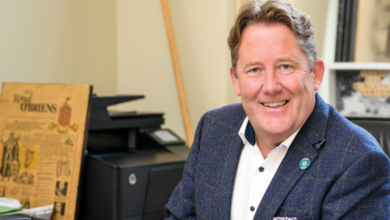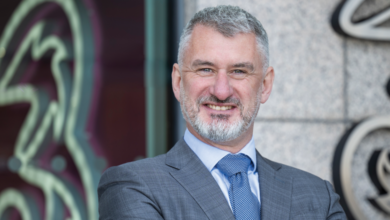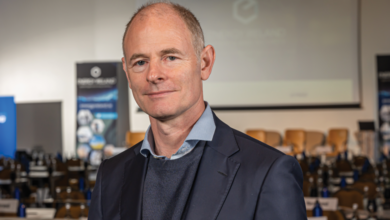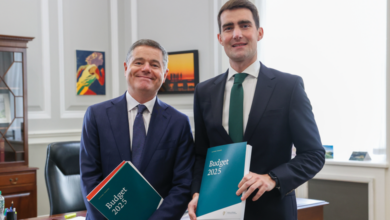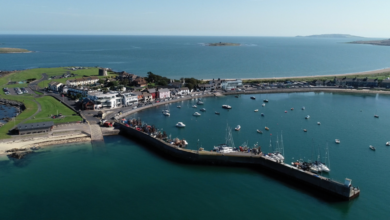Land, sea and air
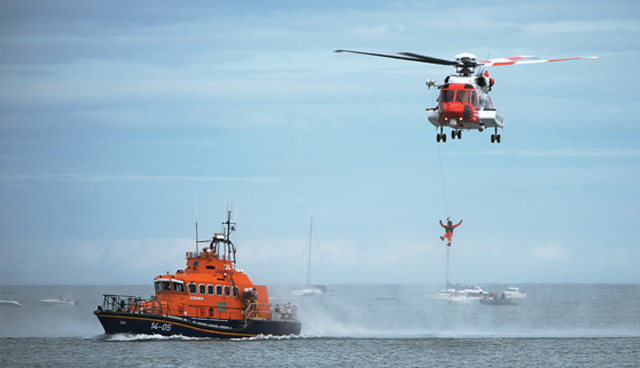

In March 2017, the tragic loss of an Irish Coast Guard (IRCG) helicopter, call sign Rescue 116, and four crew members during a search and rescue (SAR) mission over the Atlantic Ocean, brought Ireland’s fourth ‘blue light’ service to the fore of national consciousness. Ciarán Galway visits the Department of Transport to discuss the service with SAR Operations Manager Gerard O’Flynn.
The Coast Guard (Garda Cósta na hÉireann) has two primary obligations. The first relates to search and rescue which pertains to the prevention of loss of life on Ireland’s seas, on its waterways and in its remote areas. The second concerns responsibility for co-ordination of pollution response or anything to do with shipping casualties (a ship of any size getting into difficulty at sea).
As Search and Rescue Operations Manager, O’Flynn has overall responsibility for the 38 employees distributed between the Coast Guard’s two Marine Rescue Sub-Centres (MRSC) at Malin and Valentia and the Marine Rescue Co-ordination Centre (MRCC) located in Dublin. “These are 24/7 operations. Within that, we have resources which I would divide into three categories: we have our own indigenous resources, we have declared resources and the third we loosely call vessels of opportunity,” O’Flynn explains.
“Our own indigenous resources, our primary response assets, would be our Coast Guard volunteer service, our helicopters and our helicopter contract. These are supported by what we would call declared resources, the principal of which is the RNLI. After that, we also have access on a request basis to State resources, principally the Naval Service who will supply ships, navy divers, Garda divers or air support from the Air Corps.”
The SAR Manager indicates that the IRCG’s relationship with the RNLI is “seamless”. “What this means is that we have an agreed arrangement that if we see a need for a lifeboat to be tasked to a particular area, we immediately request the lifeboat to launch so that we don’t have to go through a long-winded bureaucratic system. There is very close co-ordination with the RNLI,” he elaborates.
The Coast Guard also has a secondary role in providing aeromedical support to the HSE. This incorporates a range of actions, including moving patients in inter-hospital transfers or transporting casualties requiring rapid hospitalisation, particularly from isolated rural areas and the islands. The IRCG is also on standby to transfer patients to Britain for emergency organ transplants.
“This is a role we provide on a request-basis to the National Ambulance Service and it’s significant because if a person is offered the opportunity of a transplant and they don’t get to the hospital in the UK within a very narrow window of time, often it’s too late. We’re not the primary provider, but in the current year, we have done four of those [at time of interview]. Given that the list is quite small, this is an important contribution and something that we’re very proud of,” says O’Flynn.
Geographic cover
When it comes to search and rescue, there is an internationally-agreed Irish search and rescue region. This line runs close to north, south and east coasts, but extends deep into the Atlantic, beyond 200 miles off the west coast and owes its origins to the traditional delineation of airspace. In relation to pollution response, the area of responsibility is the same as the exclusive fishery limits; Ireland’s 200-mile maritime Exclusive Economic Zone (EEZ).
“Again, it’s important to realise that when it comes to search and rescue, there is a very close and seamless relationship with the UK. So, if there is an incident, 20 or 30 miles off the south coast, it may well merit an asset response from Ireland rather than from England, because the Irish asset is much closer. Therefore, while it would be within the UK search and rescue region by definition, the interaction between the Irish Coast Guard and the UK Maritime Coastguard Agency is routine and decision making is quite rapid and efficient.
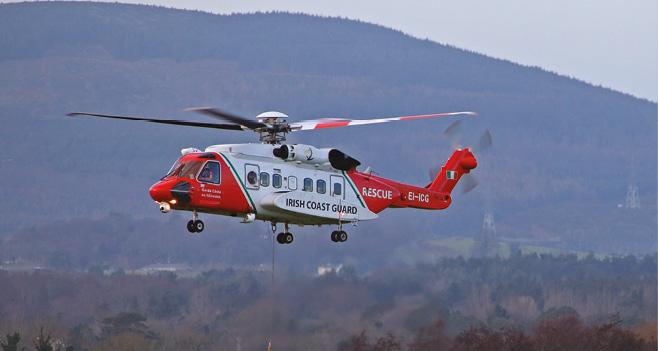
“We have an arrangement that if there is a requirement for one of our Coast Guard helicopters to support SAR in Northern Ireland, then the UK Maritime Coastguard Agency, either through Belfast or through their headquarters, will ask and we’re happy to assist. We only do it when we’re asked to do it. Likewise, if there was a major incident in the Irish Sea that required multiple response, then you would expect to see co-ordination between UK and Irish assets.”
Scale
On an annual basis, the IRCG could handle between 2,500-3,000 marine emergencies, assist around 4,500 individuals, task helicopters on 800 missions, assist other coast guards approximately 200 times, make 6,000 maritime safety broadcasts and investigate 50 maritime pollution reports.
While an incident can be something very minor, it still warrants an intervention. For instance, sometimes when a person believes they have sighted an individual in the water, upon investigation, it can transpire that it was merely a buoy.
“We would never fault anybody for raising the alarm. If you’re in doubt and don’t shout then we would be extremely concerned by that. At the opposite end of the scale, it could be a major incident requiring a major rescue,” emphasises O’Flynn.
One such incident, detailed by the SAR Manager concerned an electronic position indicating radio beacon (EPIRB) which signalled that somebody was potentially in trouble 165 miles south-west of Mizen Head. “The Coast Guard helicopter from Waterford (R117) was immediately tasked and ‘top cover’ was provided by an Air Corps CASA CN-235. When they got there, they discovered nothing but the EPIRB itself which was transmitting. They conducted a co-ordinated search operation and some miles away they located two individuals on an over-turned boat who had been rowing from Newfoundland to Ireland. That was a fairly major incident. The two guys were rescued and brought to hospital in Tralee.
“So, when I talk about incidents, some of them can be quite complex and others can be quite simple, but they all require competent people to make an evaluation and decide to bring them to a conclusion.”
To this end, an ability to develop a situational awareness is crucial to determining an appropriate response. “At the end of the day, there is risk and a cost attached to a response, so the evaluation has to be quick, safe and appropriate to the problem that has been identified.”
Organisation structure
The Coast Guard is a division of the Department of Transport and the Director of the IRCG works within a division known as the Irish Maritime Administration and heads an organisation of 56 full-time staff with most staff working within the three co-ordination centres. “On the operations side, we have a pool of approximately 38 people who work on a 24/7 basis. We also have a manager at each of those centres and then me as SAR Operations Manager,” clarifies O’Flynn.
In addition, the Coast Guard has a volunteer sector and an engineering group. The volunteer sector has approximately 950 members between 43 units across the coast of Ireland. All units are designated shoreline search units, so in effect are the eyes and the ears of the rescue co-ordination centres. If there is a report of an incident on the coast, they are equipped to investigate and provide an immediate report. Some of the units are additionally designated as boat units with vessels capable of responding while others are designated as cliff-rescue units. All the units, as an integral component of their communities, play a role in community resilience.
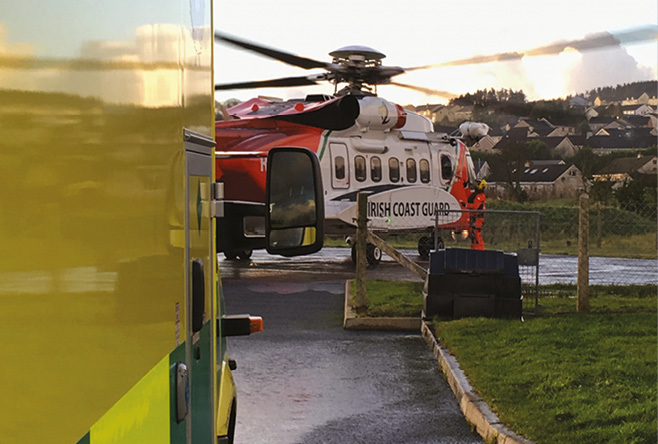
“That’s a huge commitment on the part of the volunteers,” acknowledges O’Flynn. “I would say that in terms of equipment, they’re fairly well resourced, but the biggest challenge is to not place excessive demands on their time and even at that, the demands are still high. They are an indigenous part of the Coast Guard and the Irish SAR framework. They are not paid a wage, but they wear Coast guard supplied uniforms and PPE. The only compensation they get are expenses.
“The volunteer sector is very proud of the service it provides to local communities and many of those units were established a long time ago, often simply as a local group, and over time they came under the Coast Guard umbrella. They are a wonderful resource for this country.”
Maintenance
The Coast Guard is also responsible for maintaining the marine VHF (very high frequency) network around Ireland. Describing this as “unseen work”, the SAR Manager notes: “If you are at sea and make a marine VHF broadcast, you are actually operating through a network of VHF areas and systems that are maintained by our engineering division.” Meanwhile, the maintenance of the IRCG’s sophisticated IT system is undertaken within the Department of Transport.
Similarly, the IRCG helicopter operation has been provided on a contract basis since 2012. The current contract holder or operator is CHC Helicopter Ireland. “They operate probably the best-known search and rescue helicopter in the world; the Sikorsky S-92. It is recognised as being a very modern search and rescue helicopter and is used by many other countries, including our nearest neighbours in the UK. It is also one of the most common transport vehicles used in the oil industry, so from that perspective it is modern and up-to-date.”
The core requisite of a search and rescue helicopter is a balance between a machine that has a long-range, capable of operating deep into the Atlantic, yet at the same time, one which has the capacity to work with small craft.
Awareness
Overall, the IRCG divides its approach under three different headings: how to prevent; how to prepare; and how to respond to incidents. “I suppose prevention is much better than response ultimately. For example, our volunteer teams do a school water-safety awareness programme, visiting primary schools in their locality in the run up to the summer.
“The general public are very proud of the Coast Guard and I think that anybody who has experienced dealings with volunteers or the helicopter service appreciates the professionalism and knows the value.”
“Overall, the public awareness of the Coast Guard is quite strong, even though people are perhaps unclear of the exact structure into which the service fits. I know that around the country, the general public are very proud of the Coast Guard and I think that anybody who has experienced dealings with volunteers or the helicopter service appreciates the professionalism and knows the value. This is particularly true amongst the maritime and fishing community with whom the IRCG shares a very close bond,” O’Flynn concludes.

